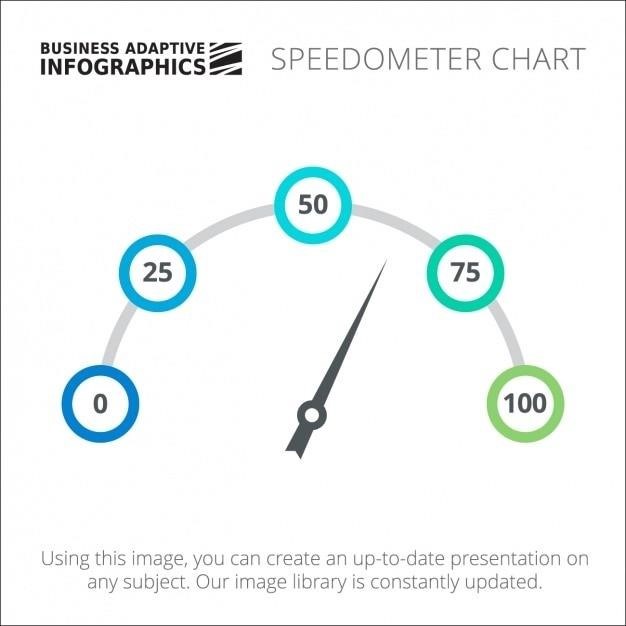Kilometers to Miles Conversion Chart⁚ A Comprehensive Guide
This comprehensive guide delves into the world of kilometers to miles conversion, providing you with valuable insights and practical tools to navigate this essential conversion process. From understanding the benefits of using a conversion chart to exploring online resources and tools, this guide equips you with the knowledge to confidently convert between these units of measurement.
Introduction
The conversion between kilometers and miles is a common task encountered in various fields, including travel, transportation, and mapping. Whether you’re planning a road trip across different countries, analyzing geographical data, or simply trying to understand the distance between two points, the ability to convert between these units is essential. A kilometers to miles conversion chart serves as a valuable tool for this purpose, providing a quick and convenient reference for converting distances between the metric and imperial systems.
This chart typically displays a list of kilometer values, alongside their corresponding mile equivalents, allowing users to easily find the desired conversion. While online calculators and conversion tools are readily available, having a printed chart can be particularly useful for those who prefer a physical reference or work in environments where internet access may be limited. Furthermore, creating a custom chart tailored to specific needs can enhance the accuracy and convenience of the conversion process.
This comprehensive guide explores the various aspects of using a kilometers to miles conversion chart, delving into the reasons for utilizing such a tool, its benefits, and the key conversion factors involved. We’ll also discuss the process of creating your own personalized chart and explore the diverse online resources available to aid in conversions. Whether you’re a seasoned traveler, a data analyst, or simply curious about understanding distances across different systems, this guide provides valuable insights and practical advice to enhance your conversion capabilities.
Why Use a Kilometers to Miles Chart?
The use of a kilometers to miles conversion chart offers a multitude of advantages, particularly in situations where quick and accurate conversions are paramount. Here are some compelling reasons why utilizing such a chart can be beneficial⁚
Convenience and Speed⁚ A conversion chart provides a readily accessible reference for converting distances between kilometers and miles. It eliminates the need for complex calculations or reliance on online tools, offering a streamlined and efficient method for obtaining conversions. This convenience is particularly valuable when working with large datasets or when time constraints are a factor.
Accuracy and Precision⁚ While online calculators and conversion tools can be helpful, they are not always reliable. A printed conversion chart offers a consistent and accurate reference, ensuring that the conversions are precise and free from errors. This is crucial for applications where accuracy is paramount, such as scientific research, engineering projects, or navigation.
Accessibility and Offline Availability⁚ Conversion charts can be easily printed and carried, making them accessible in situations where internet access may be limited or unavailable. This is particularly useful for travelers, outdoor enthusiasts, or professionals who work in remote areas.
Visual Clarity and Understanding⁚ A conversion chart presents the relationship between kilometers and miles in a clear and visually appealing format. This can enhance understanding and facilitate easier comprehension of the conversion process, especially for individuals who are not familiar with both units of measurement.
In essence, a kilometers to miles conversion chart serves as a practical and reliable tool for individuals and organizations who require frequent conversions between these units of measurement. Its convenience, accuracy, accessibility, and visual clarity make it an invaluable resource in a wide range of contexts.
Benefits of a Kilometers to Miles Chart
The use of a kilometers to miles conversion chart yields numerous benefits, making it a valuable tool for individuals and organizations across various sectors. These benefits enhance efficiency, accuracy, and ease of use, streamlining the conversion process between these commonly used units of measurement.
Enhanced Productivity⁚ A conversion chart eliminates the need for tedious manual calculations or reliance on online tools, saving valuable time and effort. This efficiency is particularly beneficial in fast-paced environments where quick conversions are crucial.
Improved Accuracy and Precision⁚ Conversion charts provide a consistent and reliable reference, ensuring accurate conversions free from errors. This accuracy is critical in applications where precision is paramount, such as engineering, scientific research, and navigation.
Enhanced Understanding and Comprehension⁚ A conversion chart visually represents the relationship between kilometers and miles, facilitating easier comprehension of the conversion process. This visual clarity is especially helpful for individuals who are unfamiliar with both units of measurement.
Increased Accessibility and Convenience⁚ Conversion charts can be readily printed and carried, making them accessible in situations where internet access may be limited or unavailable. This convenience is particularly useful for travelers, outdoor enthusiasts, and professionals who work in remote areas.
Cost-Effectiveness and Resource Optimization⁚ By eliminating the need for specialized software or subscription services, conversion charts offer a cost-effective solution for managing conversions. This resource optimization is particularly relevant for individuals and organizations with limited budgets.
In conclusion, the benefits of utilizing a kilometers to miles conversion chart are substantial, encompassing increased productivity, enhanced accuracy, improved comprehension, greater accessibility, and cost-effectiveness. These advantages make it a valuable resource for a wide range of applications and users.
Key Conversion Factors
Understanding the fundamental conversion factors is crucial for accurate conversions between kilometers and miles. These factors form the foundation of the conversion process, ensuring precise results. The primary conversion factor is the equivalence between one kilometer and one mile, which serves as the cornerstone for all calculations.
Kilometer to Mile Conversion Factor⁚ The most important conversion factor is the relationship between one kilometer and one mile. One kilometer is approximately equal to 0.621371192 miles. This factor is used to convert kilometers to miles by multiplying the distance in kilometers by this value.
Mile to Kilometer Conversion Factor⁚ Conversely, one mile is equivalent to approximately 1.609344 kilometers. This factor is used to convert miles to kilometers by multiplying the distance in miles by this value.
These conversion factors can be applied using a variety of methods, including manual calculations, online tools, or conversion charts. Regardless of the method chosen, understanding these factors is essential for accurate and reliable conversions.
While these factors are typically rounded to a few decimal places for practical purposes, it’s important to remember that the exact conversion is a more complex decimal value. The use of these factors allows for a seamless and consistent conversion process, ensuring accurate results across various applications.
Understanding these key conversion factors is crucial for accurate conversions between kilometers and miles. This knowledge empowers users to confidently navigate these units of measurement, ensuring precision in various applications and contexts.
Creating Your Own Kilometers to Miles Chart
Creating your own kilometers to miles conversion chart can be a valuable tool for quick and convenient conversions. It provides a visual representation of the relationship between these units, enabling you to easily reference distances in either kilometers or miles. This section guides you through the process of creating your own chart, allowing you to customize it to meet your specific needs.
Determine the Range⁚ Begin by deciding on the range of kilometers or miles you wish to include in your chart. Consider the typical distances you encounter in your everyday life or the specific applications for which you need the conversion.
Choose Intervals⁚ Once you have defined the range, determine the intervals at which you want to display the conversions. You can opt for consistent intervals, such as every kilometer or every mile, or use intervals that are more relevant to your specific needs.
Calculate Conversions⁚ Using the key conversion factors discussed earlier, calculate the corresponding miles for each kilometer value in your chart. Similarly, if you are creating a chart from miles to kilometers, calculate the kilometer values for each mile.
Format the Chart⁚ Organize the conversions into a clear and concise format. You can present the chart as a table, with kilometers in one column and miles in the other, or create a visual representation using a graph or a line chart.
Customize and Refine⁚ Customize the chart to meet your specific requirements. This could involve adding labels, titles, or even including additional information, such as the conversion factor used or the precision level of the conversions.
By following these steps, you can create a customized kilometers to miles conversion chart tailored to your specific needs, providing a readily available resource for quick and accurate conversions.
Using a Kilometers to Miles Chart
Using a kilometers to miles conversion chart is a simple and straightforward process that can save you time and effort when dealing with distances expressed in different units. Whether you’re planning a trip, interpreting road signs, or analyzing data, a conversion chart can be a valuable tool for quick and accurate conversions. This section provides a step-by-step guide on how to effectively use a kilometers to miles conversion chart.
Identify the Distance⁚ Begin by identifying the distance you need to convert. This could be a distance expressed in kilometers, miles, or any other unit that requires conversion.

Locate the Chart⁚ Access your kilometers to miles conversion chart. This could be a printed chart, a digital document, or an online tool.
Find the Corresponding Value⁚ Locate the distance you need to convert on the chart. If the chart is organized by kilometers, find the corresponding kilometer value and read the equivalent mile value in the adjacent column. If the chart is organized by miles, find the corresponding mile value and read the equivalent kilometer value.
Verify Accuracy⁚ Double-check the conversion to ensure accuracy, especially if you are dealing with critical measurements. You can verify your conversion using an online calculator or by performing the calculation manually.
Apply the Conversion⁚ Once you have successfully converted the distance, use the converted value in your calculations or analysis.

By following these simple steps, you can effectively use a kilometers to miles conversion chart to facilitate conversions and ensure accurate measurements in any situation where you need to work with distances expressed in different units.
Online Resources and Tools
The digital age has revolutionized the way we access information, including conversion tools. The internet offers a plethora of online resources and tools dedicated to simplifying the conversion process between kilometers and miles. These resources provide convenient and accurate solutions for users seeking quick conversions without the need for manual calculations or printed charts.
Online Converters⁚ Numerous websites offer dedicated kilometers to miles conversion tools. These online converters typically feature user-friendly interfaces where you can simply input the value you want to convert and obtain the equivalent value in the desired unit. Many online converters also offer additional features, such as the ability to convert between multiple units of measurement or generate charts for quick reference.
Search Engines⁚ Search engines like Google can also be used for quick conversions. Simply type “convert kilometers to miles” followed by the value you want to convert into the search bar. Google will instantly display the converted value, eliminating the need to navigate to a separate conversion website.
Spreadsheet Software⁚ If you frequently need to perform conversions, spreadsheet software like Microsoft Excel or Google Sheets can be invaluable. These programs allow you to create custom conversion tables or use built-in formulas to automatically convert values between kilometers and miles.
Mobile Applications⁚ Smartphone apps offer another convenient way to access conversion tools on the go. Several free and paid apps are available that specialize in unit conversions, providing quick and easy access to kilometers to miles conversions directly from your mobile device.
These online resources and tools offer a wide range of options for converting between kilometers and miles, catering to different user needs and preferences. Whether you need a quick conversion, a comprehensive chart, or an automated solution, the internet provides readily accessible tools to simplify the conversion process.

